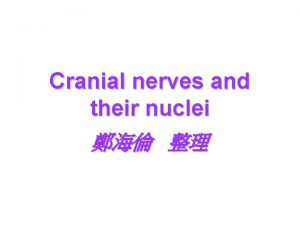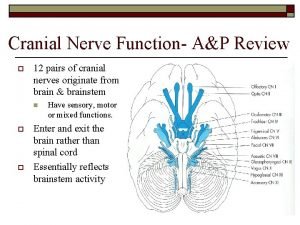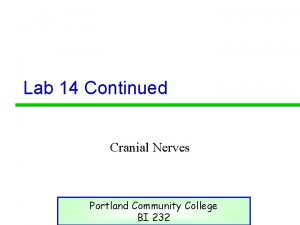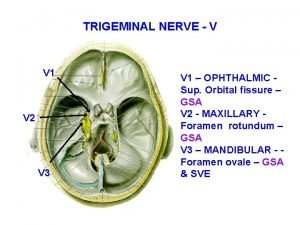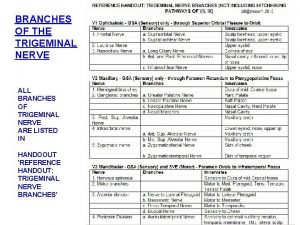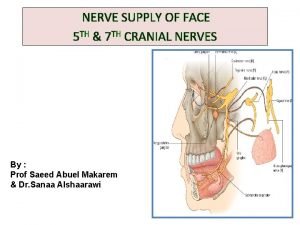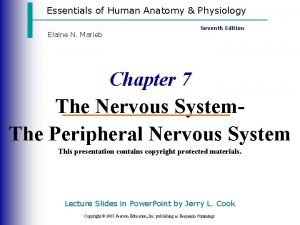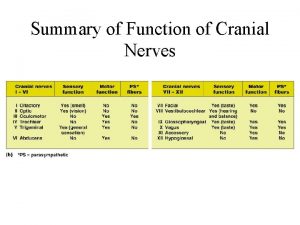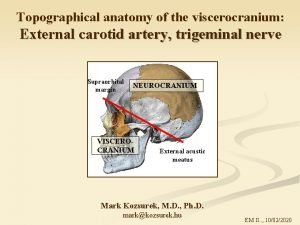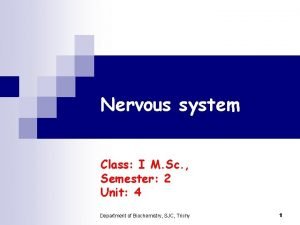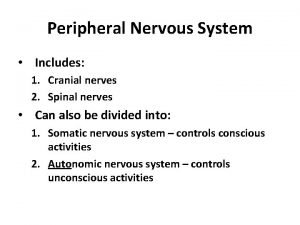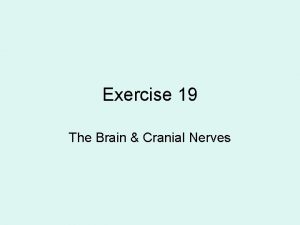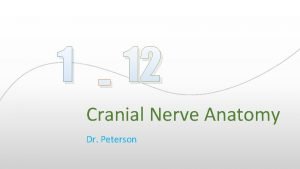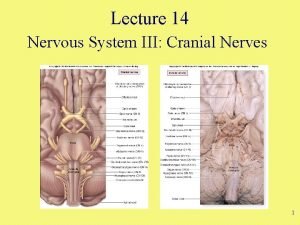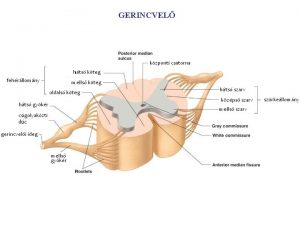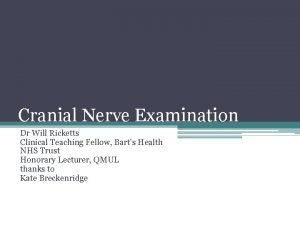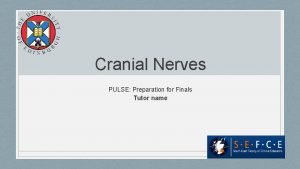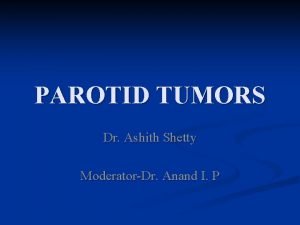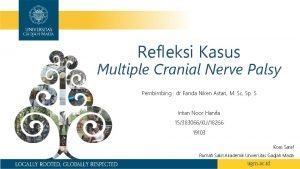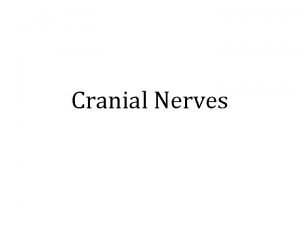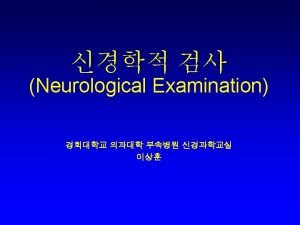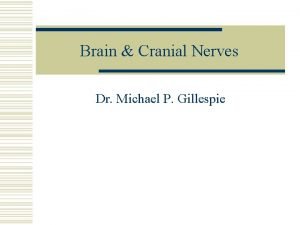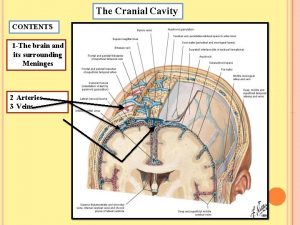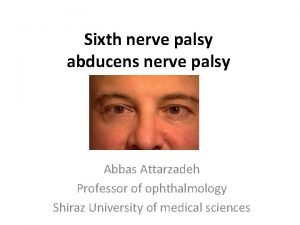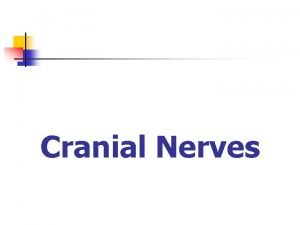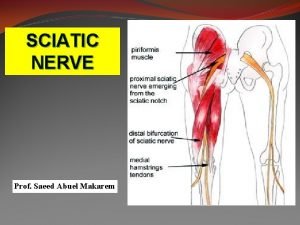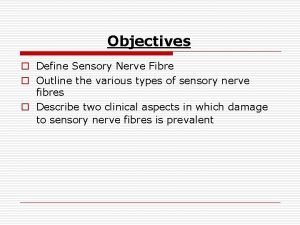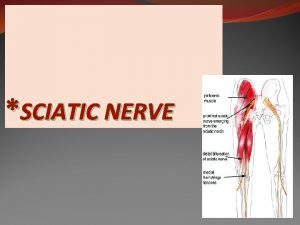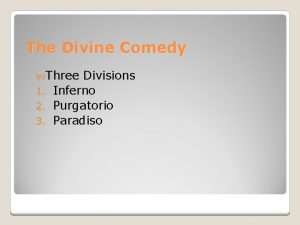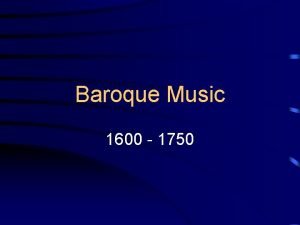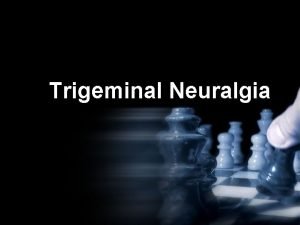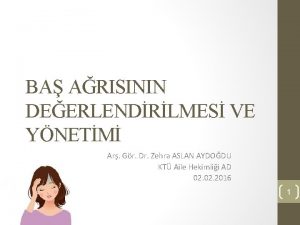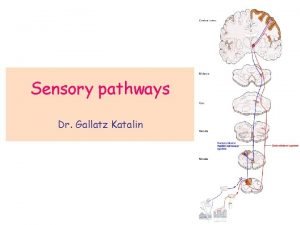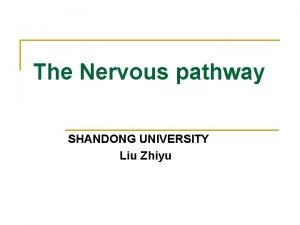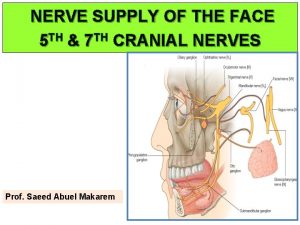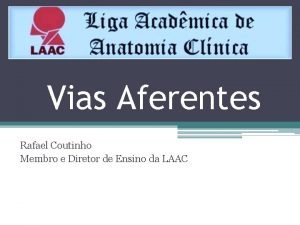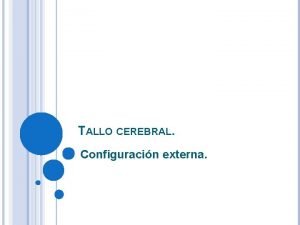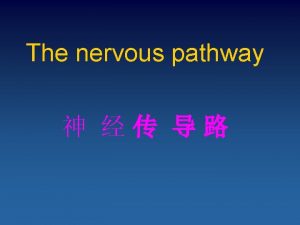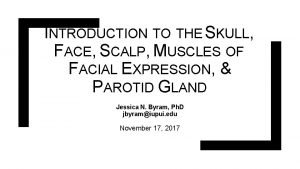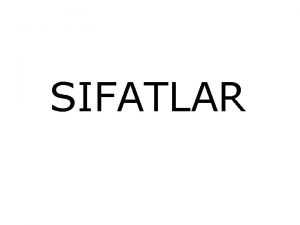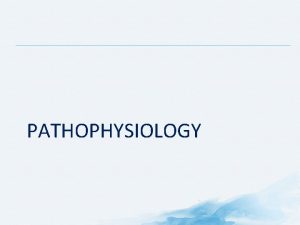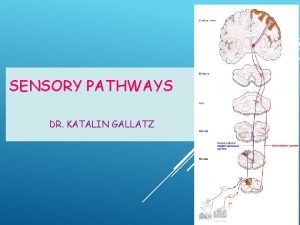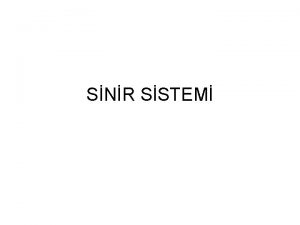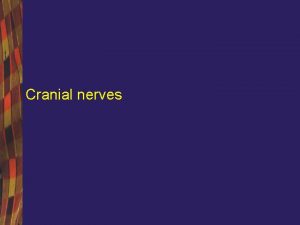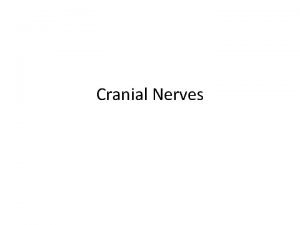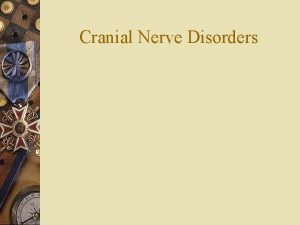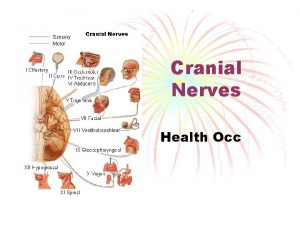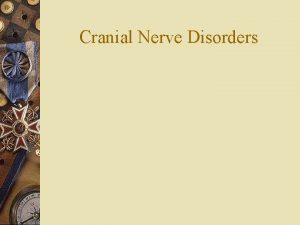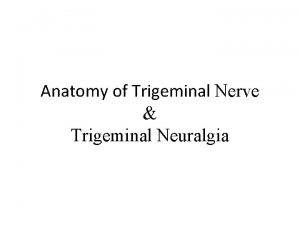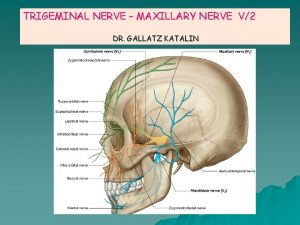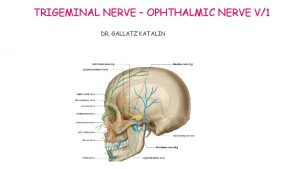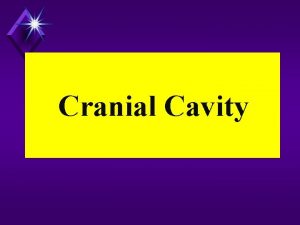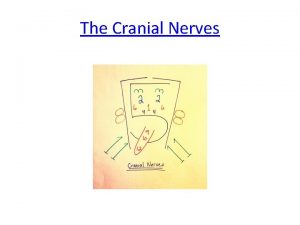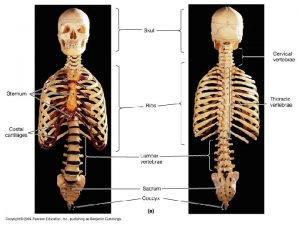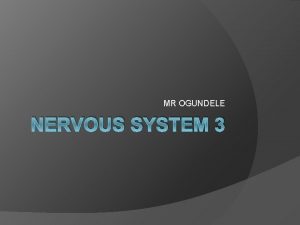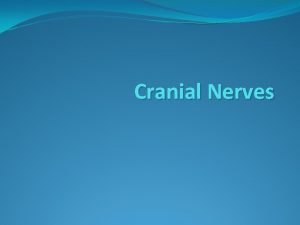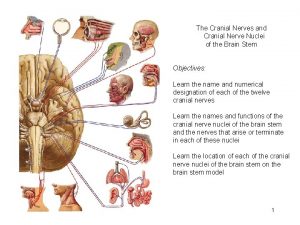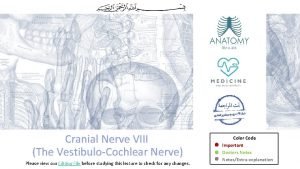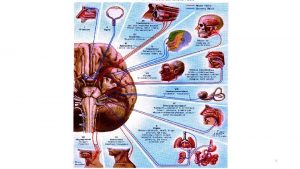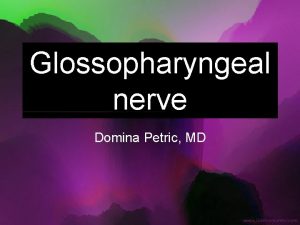Cranial Nerve V Trigeminal Three divisions Conveys sensory






















































- Slides: 54

Cranial Nerve V: Trigeminal • Three divisions: – – – • Conveys sensory impulses from various areas of the face (V 1) and (V 2), and supplies motor fibers (V 3) for _

Cranial Nerve V: Trigeminal

Cranial Nerve VI: Abdcuens • Fibers leave the inferior pons and enter the orbit via the superior orbital fissure • Primarily a ______________innervating the _

Cranial Nerve VII: Facial • Fibers leave the pons, travel through the ___________________, and emerge through the stylomastoid foramen to the lateral aspect of the face • ___________________ with five major branches • Motor functions __________________, and the transmittal of autonomic impulses to lacrimal and salivary glands • Sensory function is _____________ from the anterior two-thirds of the tongue

Cranial Nerve VII: Facial

Cranial Nerve VIII: Vestibulocochlear • Fibers arise from the hearing and equilibrium apparatus of the inner ear, pass through the internal acoustic meatus, and enter the brainstem at the pons-medulla border • Two divisions – • Functions are solely sensory –

Cranial Nerve VIII: Vestibulocochlear

Cranial Nerve IX: Glossopharyngeal • Fibers emerge from the medulla, leave the skull via the jugular foramen, and run to the _ • Nerve IX is a ________________ with motor and sensory functions • Motor – innervates part of the _______________________, and provides motor fibers to the parotid salivary gland • Sensory – fibers conduct __________________ and general sensory impulses from the _

Cranial Nerve IX: Glossopharyngeal

Cranial Nerve X: Vagus • The _____________ cranial nerve that extends _ • Fibers emerge from the medulla via the jugular foramen • The vagus is a _ • Most motor fibers are ___________________ to the heart, lungs, and visceral organs • Its sensory function is in _

Cranial Nerve X: Vagus

Cranial Nerve XI: Accessory • Formed from a cranial root emerging from the medulla ________________________ arising from the superior region of the spinal cord • The spinal root passes upward into the cranium via the foramen magnum • The accessory nerve leaves the cranium via the jugular foramen

Cranial Nerve XI: Accessory • Primarily a motor nerve – Supplies fibers to the _ – Innervates the _____________________, which move the head and neck

Cranial Nerve XI: Accessory

Cranial Nerve XII: Hypoglossal • Fibers arise from the medulla and exit the skull via the _ • Innervates both ___________________ of the tongue, which contribute to _

Cranial Nerve XII: Hypoglossal

Spinal Nerves • Thirty-one pairs of mixed nerves arise from the spinal cord and supply _ • They are named according to their point of issue – – – 8 cervical (C 1 -C 8) 12 thoracic (T 1 -T 12) 5 Lumbar (L 1 -L 5) 5 Sacral (S 1 -S 5) 1 Coccygeal (C 0)

Spinal Nerves: Roots • Each spinal nerve connects to the spinal cord via _ • Each root forms a series of rootlets that attach to the spinal cord • __________________ arise from the _________________and contain _ • Dorsal roots arise from ____________________ in the dorsal root ganglion and contain sensory (afferent) fibers

Spinal Nerves: Roots

Spinal Nerves: Rami • The short spinal nerves branch into three or four mixed, distal rami – – – Tiny _ – Rami communicantes at the base of the ventral rami in the thoracic region

Nerve Plexuses • All ventral rami except T 2 -T 12 form interlacing nerve ______________called _ • Plexuses are found in the cervical, brachial, lumbar, and sacral regions • Each resulting branch of a plexus contains _

Nerve Plexuses • Fibers travel to the periphery via several different routes • Each muscle receives a nerve supply _ • Damage to ___________________ cannot completely paralyze a muscle

Spinal Nerve Innervation: • The back is innervated by _______________ via several branches • The thorax is innervated by _________________ T 1 T 12 as intercostal nerves • Intercostal nerves supply muscles of the ribs, anterolateral thorax, and abdominal wall

Cervical Plexus • The _________________ is formed by ventral rami of C 1 -C 4 • Most branches are ________________ nerves of the neck, ear, back of head, and shoulders • The most important nerve of this plexus is the _ • The phrenic nerve is the major _

Cervical Plexus

Brachial Plexus • Formed by C 5 -C 8 and T 1 (C 4 and T 2 may also contribute to this plexus) • It gives rise to the _

Brachial Plexus • There are four major branches of this plexus – ____________________ – five ventral rami (C 5 -T 1) – ____________________– upper, middle, and lower, which form divisions – ____________________– anterior and posterior serve the front and back of the limb – ____________________– lateral, medial, and posterior fiber bundles

Brachial Plexus

Brachial Plexus: Nerves • Axillary – • Musculocutaneous – sends fibers to the biceps brachii and brachialis • – branches to most of the flexor muscles of arm • – supplies the flexor carpi ulnaris and part of the flexor digitorum profundus • Radial – innervates essentially all _

Lumbar Plexus • Arises from L 1 -L 4 and innervates the _ • The major nerves are the _

Lumbar Plexus Figure 13. 10

Sacral Plexus • Arises from L 4 -S 4 and serves the buttock, lower limb, pelvic structures, and the perineum • The major nerve is the _ • The sciatic is actually composed of two nerves: – –

Sacral Plexus

Innervation of Joints • Hilton’s law: any nerve serving a muscle that produces _______________ at a joint also innervates the _

Reflexes • A reflex is a _ • Reflexes may: – Be inborn _ – Involve only peripheral nerves and the _ – Involve higher brain centers as well

Reflex Arc • There are five components of a reflex arc – • site of stimulus – • transmits the afferent impulse to the CNS – • either monosynaptic or polysynaptic region within the CNS – • conducts efferent impulses from the integration center to an effector – • muscle fiber or gland that responds to the efferent impulse

Reflex Arc Figure 13. 14

Stretch and Deep Tendon Reflexes • For skeletal muscles to perform normally: – The Golgi tendon organs (____________________) must constantly inform the brain as to the state of the muscle – Stretch reflexes initiated by muscle spindles must maintain healthy _

Muscle Spindles • Muscle spindles are wrapped with ___________________: primary sensory endings of type Ia fibers and secondary sensory endings of type II fibers • These regions are innervated by gamma ( ) efferent fibers • Note: contractile muscle fibers are extrafusal fibers and are innervated by alpha ( ) efferent fibers

Muscle Spindles Figure 13. 15

Operation of the Muscle Spindles • _________________ the muscles activates the muscle spindle – There is an ______________________ in Ia fibers • __________________ the muscle ____________________ on the muscle spindle – There is a decreased rate of action potential on Ia fibers

Operation of the Muscle Spindle Figure 13. 17

Stretch Reflex • Stretching the muscle _ • Excited motor neurons of the spindle cause the stretched muscle to contract • Afferent impulses from the spindle result in inhibition of the antagonist • Example: – Tapping the patellar tendon _ – The quadriceps contract and the _

Stretch Reflex

Golgi Tendon Reflex • The _______________ of the stretch reflex • __________________ the muscle _ • Afferent Golgi tendon neurons are stimulated, neurons inhibit the contracting muscle, and the antagonistic muscle is activated • As a result, the contracting muscle relaxes and the antagonist contracts

Golgi Tendon Reflex

Flexor and Crossed Extensor Reflexes • ___________________ is initiated by a _____________ stimulus (actual or perceived) that causes automatic ___________________ of the threatened body part • The crossed extensor reflex has two parts – The stimulated side is _ – The _

Crossed Extensor Reflex Interneurons + + – Afferent fiber + – + Efferent fibers Extensor inhibited Flexor stimulated xes Flexor inhibited Arm movements Extensor stimulated nds Exte Key: + Excitatory synapse – Inhibitory synapse Right arm (site of stimulus) Left arm (site of reciprocal activation)

Superficial Reflexes • Initiated by gentle __________________ stimulation • Example: – _____________________ is initiated by stimulating the lateral aspect of the sole of the foot – The response is _ – Indirectly tests for proper ______________________ functioning – _____________________ : abnormal plantar reflex indicating corticospinal damage where the great toe dorsiflexes and the smaller toes fan laterally

Autonomic Nervous System (ANS) • The ANS consists of motor neurons that: – Innervate _ – Make adjustments to ensure optimal support for body activities – Operate via _ – Have __________________ as most of their _


ANS Versus Somatic Nervous System (SNS) • The ANS differs from the SNS in the following three areas – – Efferent _ – Target organ responses

Effectors • The effectors of the _______ are _ • The effectors of the ________ are _

Efferent Pathways • ___________________ axons of the ____________________ extend from the CNS to the effector • Axons of the ANS are a _ – The ___________________ (first) neuron has a lightly myelinated axon – The ____________________ (second) neuron extends to an effector organ
 Trigeminal nerve which cranial nerve
Trigeminal nerve which cranial nerve Cranial nerve 9
Cranial nerve 9 Cranial nerves mixed sensory motor
Cranial nerves mixed sensory motor V
V Trigeminal nerve foramen
Trigeminal nerve foramen 5th nerve palsy
5th nerve palsy Cranial nerves sensory and motor
Cranial nerves sensory and motor Define clinical anatomy
Define clinical anatomy Cn i
Cn i Stephen hawking
Stephen hawking Sensory cranial nerves
Sensory cranial nerves Eca branches
Eca branches Properties of nerve
Properties of nerve Grey commissure
Grey commissure Middle cranial fossa
Middle cranial fossa Meningitis symptoms baby
Meningitis symptoms baby Oculomotor nerve nucleus
Oculomotor nerve nucleus Cranial nerves mnemonic
Cranial nerves mnemonic Cranial nerve
Cranial nerve Accessory nerve xi
Accessory nerve xi Old opie occasionally tries
Old opie occasionally tries érző homunculus
érző homunculus Pupillary light reflex test
Pupillary light reflex test Cranial nerve osce
Cranial nerve osce Dr ashith shetty
Dr ashith shetty Multiple cranial nerve palsy adalah
Multiple cranial nerve palsy adalah Proprioception cranial nerves
Proprioception cranial nerves The cranial nerves labeled
The cranial nerves labeled Cranial nerve testing
Cranial nerve testing Oculomotor paralysis
Oculomotor paralysis Tentorium cerebelli cranial nerve
Tentorium cerebelli cranial nerve Cranial nerve palsy
Cranial nerve palsy Cranial nerves and special senses
Cranial nerves and special senses Sciatic nerve sensory distribution
Sciatic nerve sensory distribution Sensory nerve types
Sensory nerve types Motor and sensory nerve
Motor and sensory nerve Sciatic nerve motor or sensory
Sciatic nerve motor or sensory Three divisions of comedy
Three divisions of comedy What conveys unity of mood in baroque music?
What conveys unity of mood in baroque music? Nervus trigeminus inflammation
Nervus trigeminus inflammation Trigeminal otonomik sefalji
Trigeminal otonomik sefalji Supraperiosteal definition
Supraperiosteal definition Gallatz
Gallatz Divalproex
Divalproex Optic tract
Optic tract Trigeminal impression
Trigeminal impression Via trigeminal proprioceptiva
Via trigeminal proprioceptiva Trigeminal migraine
Trigeminal migraine Tallo encefalico
Tallo encefalico Trigeminal touch pathway
Trigeminal touch pathway Foramina of the face
Foramina of the face Latince rakamlar
Latince rakamlar Sunct
Sunct Protopathic touch
Protopathic touch Topognozi nedir
Topognozi nedir
